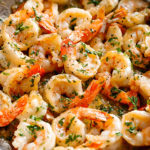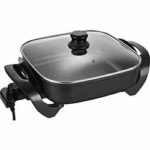Last updated: 30 Apr 2023
Eating healthy while traveling in an RV can be a bit of a challenge, especially if you’re on the road a lot and don’t have easy access to supermarkets or restaurants that serve healthy options. However, it is possible to maintain a healthy diet while on the go.
Below are some food and supplement recommendations that have worked well for me and are easy to incorporate into a mobile lifestyle. If you’re interested in learning more about why I recommend these, you can find more information at the bottom of the page.
Disclaimer: Please be aware that I am not a doctor, not a scientist nor a nutritionist. So please – whenever you change your diet radically, you better consult with a doctor or with a nutritionist.
Nuts
Nuts – you gotta appreciate these little ones because they are healthy, very nutritious, good for a yummy snack, and because they deliver a lot of energy for how little they are. Here is a great summary of the best nuts.

You can make your trail mix. Check your favorite grocery store if they have any bulk items. Grab a bit of all that appeals to you and then just throw it together at home.
Other than all these nuts, I found raisins as a classic, blueberries, and cranberries a nice addition. Then there are roasted soybeans which usually contain a bit of salt and there is dried Edamame!
One drawback of nuts is that they do not have an infinite shelf life. To prolong their freshness, it’s best to keep them sealed in a bag in the fridge. As long as they are kept dry and cool, they should be fine for weeks.
Almond Milk
You can use almond milk to replace animal milk in virtually all recipes. Why would I do that you ask? Because: Almond milk has less fat and fewer calories than cow milk and it does not contain cholesterol or lactose.
Almond milk has a distinctive nutty taste, but not to the point that it would overpower any recipe you’d prepare with it. I use it as a “creamer” in my coffee and there you can taste the almonds a bit. Doing so for a while, I like it so much that I don’t want to go back to cow milk.
Almond milk stays freshly refrigerated for about 10 days after opening. This also makes it a good partner for the road. Nowadays you can get it in almost any grocery store. Half a gallon costs you around $3-4. I recommend the unsweetened versions. If you are up to it, you can try making almond milk yourself. I did this for a while and this is a treat. Just too much of a hassle to do it continuously as I go through at least 2 gallons/week.
Vitamin Supplements
While it’s true that vitamin supplements can be helpful in ensuring you get all the necessary nutrients, it’s important to remember that they should not replace a healthy, balanced diet. It’s always best to get your vitamins and minerals from whole foods whenever possible. Additionally, it’s important to consult with a healthcare professional before starting any new vitamin supplement regimen to ensure that it’s safe and appropriate for you.
I was taking various multivitamins off and on because – well, just because. Up until now, I’m a big fan of fish oil with lemon. Besides all the benefits of fish oil, I like this lemon flavor and that this oil does not “repeat” on you whatsoever.
Juicing

Juicing is what I did for a while. You might like the concept and benefits of it, but I stopped doing it because it’s just too much of a hassle for me. Especially once on the road, it’s gonna be hard to always have fresh veggies on hand. If you have the chance to stop by a local farmers market or any other place where you can source quality veggies once a week AND you have pleasure doing the juicing action – go for it!
Nutrition-wise, there is not much better than fresh veggie juice. Just make sure that you buy either organic or wash the produce thoroughly (a mix of cheap vinegar and a dash of Dr. Bronner’s soap worked well for me) as otherwise, you would mainline the toxins (from spraying herbicides and pesticides) right into your system.
Amazing Grass
You probably agree that it can’t compete with fresh veggie juice, but you should try it because it is a decent alternative to constant juicing. Amazing grass claims “…Help you achieve your recommended 5 to 9 daily servings of fruits and vegetables”. I can’t prove that but I think that I have more energy since I use it. This one also contains some probiotics.
Here is how I take it in: take your favorite blender, add 1 banana, 3 tablespoons of yogurt, 1 scoop of Amazing grass, and one teaspoon of Cacao powder. Top it off with almond milk and blend it for a bit. Be warned – it’s gonna be a brownish-green soup, but it’s TASTY! I pour that over my cereal (1 part granola for the crunch, 1 part oatmeal, 1 part Kamut puffs, and 1 tablespoon of oat bran. This will get you going from early morning till lunch.
Kamut Puffs
Kamut puffs – a kick-ass cereal because it’s a whole grain, it is extremely low on carbs but high in dietarian fiber, and because of its puffed state, it fills you up real good – which makes it a winner in the “cereal for the road” department.
Unopened bags stay good for about a year. Once opened, keep it dry and you’ll be fine for a few weeks.

Cacao Powder
Cacao Powder – I love, love, love the natural taste of the cacao beans. There is no artificial sugar and no filler in there – just plain grounded organic cacao beans. I put it in my cereal (see above) and into my protein shake (see below).
One 16oz pack lasts me about a month by taking at least one scoop/day. Does not need to be refrigerated – and I store it in the handy vessel I mention 2 products below.
Freeze-Dried Food
Freeze-dried food can be a convenient option for camping or RV trips as they are lightweight, have a long shelf life, and are easy to prepare. There are companies that specialize in producing high-quality freeze-dried and dehydrated foods that can be a good option for those on the go.
Honeyville Foods and Harmony House Foods are two of them. I’m a big fan of the quality Harmony House has to offer. I also like that they” guarantee” that “all our products are 3′rd party audited and tested and are guaranteed free from any heavy metals, chemicals, or pesticides.”
I can highly recommend their 30 pack deluxe sampler to get you started and see how you like it. Otherwise order onions, corn, sweet peas, cabbage, sweet potatoes, mushrooms, tomatoes, broccoli, green beans, and carrots, because – in case you care – these are the least pesticides/herbicides contaminated. Go with mangoes, papaya, bananas, and blueberries in the freeze-dried food department. It’s a perfect backup if you run out of fresh groceries and it’s great for people without a fridge.
You will appreciate the advantages of these products: The shelf life is 1 to 2 years, it seems that the nutritions are very well preserved and they are so easy to prepare – just add water. And it’s pretty economical too.
Protein
Some people complain about a chalky taste. I don’t feel that way at all. I usually can’t wait to have a smoothie with it after a workout. I take my trusty old blender and I put one scoop of it in there along with a banana, sometimes a scoop of my beloved cacao powder, then I ad about 5 to 10 oz of (plain organic) yogurt in there and fill it up with almond milk. A quick blend and you’re happy.
Here’s How I Came Up With All That
For most of my life, I’ve been conscious about what I eat but I never paid close attention to how which food affects me in which way. The main reason for that was, that my body just could take about anything while keep feeling just fine. In recent years my body seems to start telling and showing me what food and nutrition he likes. I’m pretty sure this has to do with getting older 😉
I think it was in 2008, I watched the movie “Food Matters“. In my opinion, quite a few quacks have a say in that flick but it sure reminded me of how much it matters what you put into your body. “You are what you eat” certainly has its truth. Your stomach is such an important organ because it is the main tool that keeps your body healthy as the majority of the immune system is located right there.
Quality food = healthy immune system = healthy body = good life = happy camper 🙂 So in early 2010, after reading a lot about nutrition, calories, fats, BMI’s, superfoods, cholesterol, supplements, etc., I carefully started testing all these theories on myself.



